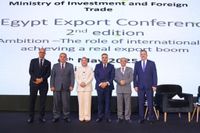In a surprising twist, Donald Trump’s recent global tariff regime is poised to benefit Brazilian agriculture significantly. Following the imposition of a staggering 145% tariff on Chinese imports last month, China retaliated with its own measures targeting American farmers, a demographic crucial to Trump’s voter base. This has opened the door for Brazilian farmers to step in and fill the void left by American agricultural exports.
Last year, China was among the top three destinations for U.S. agricultural products, with exports valued at nearly $25 billion. However, this year’s figures are unlikely to match that number. In March 2025, Chinese President Xi Jinping announced additional tariffs of 15% on U.S. chicken, wheat, corn, and cotton, along with a 10% increase on sorghum, soybeans, pork, beef, seafood, fruits, vegetables, and dairy. Subsequently, China imposed an eye-watering 125% tariff on U.S. soybeans, which has effectively created a market opportunity for Brazil.
Brazilian farmers are well-positioned to replace American products, as they can supply soybeans, corn, chicken, and eggs. Fortunately for them, Brazilian chicken farms have remained unaffected by recent bird flu outbreaks, allowing them to export poultry to Asian markets. Japan, for instance, could emerge as a new market for Brazilian meat. Last year, Japan imported 40% of its beef from the U.S., but new American tariffs on auto imports have strained relations. Brazilian President Luiz Inacio Lula da Silva recently suggested that Japan consider Brazilian meat as an alternative.
The European Union is also looking towards Brazil. In December, the EU signed a deal with Mercosur, which includes Brazil, that would eliminate 90% of tariffs between Europe and the South American bloc. This agreement is pending ratification by the individual EU member states. Brazil’s Finance Minister Fernando Haddad visited the EU at the end of March 2025 to underscore the advantages of this deal for Brazilian exports.
Ironically, while American consumers may find themselves deprived of cheap Chinese footwear due to these tariffs, they might turn to Brazilian alternatives. Brazil is the largest shoe producer outside of Asia, thanks to its abundant leather supply, and could see a surge in exports as American consumers seek new sources for affordable footwear.
Meanwhile, in Egypt, senior officials are working to bolster the country’s export capabilities through a series of initiatives unveiled at the second edition of the Egypt Export – Reality and Ambition conference. The event, organized by Expo Consultants Global in partnership with DMG Events, highlighted the growing collaboration between Egypt’s public and private sectors aimed at driving export growth.
Khaled Sofy, Chairperson of the Egyptian Organization for Standardization and Quality (EOS), announced that the organization is now issuing ISO 17065-accredited certificates at minimal cost, which will facilitate easier access for Egyptian products to global markets. He also mentioned that EOS is coordinating with over 500 industrial partners to develop a unified national quality framework to enhance export competitiveness.
Osama Basha, Minister Plenipotentiary and Head of the Arab Countries Department at the Egyptian Commercial Service, emphasized the agency’s role in safeguarding exporters by conducting thorough assessments of potential foreign partners. He noted an increase in communication efforts and a focus on raising awareness among Egyptian exporters regarding the support services available to them.
Ahmed Abdel Maksoud, Director General of Exhibitor Affairs at the General Organization for Exhibitions and Conferences, stressed the importance of boosting Egypt’s participation in international trade exhibitions. These platforms enable Egyptian producers to benchmark against global standards, attract new customers, and explore fresh market opportunities. New export support regulations are also under development, with a focus on locally manufactured goods to enhance value addition.
Dalia Shahab, Head of the Central Department for Industrial and Non-Industrial Imports at the General Organization for Export and Import Control (GOEIC), introduced a multilingual digital platform that offers around-the-clock support to exporters. She highlighted efforts to expedite customs clearance through flexible solutions and ISO-accredited inspection services provided by certified labs at ports. GOEIC also operates a quality center that provides training and consulting services to help exporters meet international standards more efficiently.
Kamal El Dessouky, a Board Member of the Federation of Egyptian Industries, reaffirmed the government’s commitment to supporting exporters through the Ministries of Industry, Foreign Trade, and Investment. He called for stronger public-private collaboration to tackle systemic challenges and achieve the targets set out in Egypt’s Vision 2030. El Dessouky stressed that effective export support must extend beyond financial incentives to include improvements in product quality, streamlined customs processes, and access to actionable market intelligence.
He further emphasized the untapped potential of the private sector, which hinges on greater legislative flexibility, improved access to finance, and enhanced technical and training support. Continuous dialogue between policymakers and business leaders is essential to develop export strategies that are grounded in practical experience and aligned with global best practices.
In Norway, the seafood industry is also witnessing a boom, despite looming tariffs. The value of Norwegian seafood exports in April 2025 increased by 2% compared to the same month last year. According to Christian Chramer, CEO of the Norwegian Seafood Council, Norway has never before exported seafood for a higher value in April. The growth is attributed to increased export volumes and rising demand for Norwegian salmon in key markets such as the USA and China.
So far this year, Norway has exported seafood worth NOK 58.5 billion (approximately €5 billion), marking a 7.3% increase compared to the same period last year. In April alone, salmon accounted for 71% of the export value, with NOK 10 billion (approximately €856 million) worth of salmon exported. Chramer noted that a shift is occurring in the flow of salmon from Europe to overseas markets, driven by higher sea temperatures and fewer biological challenges, resulting in superior quality salmon available for export.
Exports to the USA have increased for the fourth consecutive month. Additionally, exports of Arctic king crab have shown remarkable growth, with Norway exporting 97 tonnes worth NOK 41 million (€3.5 million) in April 2025, marking a staggering 110% increase compared to April of last year.
As global trade dynamics shift and countries adapt to new tariffs and trade agreements, the agricultural and export sectors in Brazil, Egypt, and Norway are poised for growth, capitalizing on emerging opportunities in international markets.





